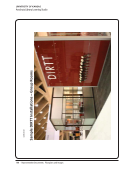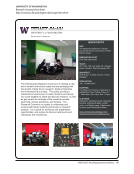30 · Survey Results: Survey Questions and Responses
4. Which of the following factors were significant drivers in the decision to make this service
reconfiguration? Check all that apply. N=52
Change in service philosophy 39 75%
User demands 29 56%
Physical change to a building or facility 24 46%
Change to library financial resources 22 42%
Changes in library staff resources 22 42%
Availability/application of new technology 18 35%
Opportunity for collaboration with a partner outside the library 13 25%
Opportunity for outsourcing service delivery 3 6%
Other factor 18 35%
Please briefly describe the other factor.
Academic department requested their space back.
Changes in university enrollment [a factor] in branch closing.
Consolidation was driven by a desire to make the most efficient use of staff, to make services offered available more
hours, and to bring more services together on one floor—centralize patron service as much as possible.
Having two service points with different purposes so close together was not efficient and very confusing to users. It was
also often difficult for students at the computer lab service point to separate technical questions from content questions.
Library Strategic Plan.
Need to reclaim prime space on busy main floor.
Offer consistent level of service to all constituents.
Our model for offering reference service at the desk has changed over time. In the new organization, most of our library
service desks are staffed by access services staff (mostly paraprofessionals) with on-call reference service Monday–
Friday, 12pm–4pm. On call arrangements are made via telephone, walkie talkie or Instant Messenger. This was a
response to trends in reference transactions at the service desk over time, and to permit librarians to work on liaison
activities, outreach, instruction, and collections activities.
Provost offered to invest in space that would expand informal learning locations and options for students (Research
Commons).
Recently implemented data gathering mechanisms allowed us to identify locations that had the capacity to take on
additional work.
Reduction in support staffing and reconfiguring staff positions led to fewer open hours.
The education school has been transitioning and shifting focus in terms of curriculum and research. It is becoming more
research oriented and wanted a collaboration space.
The space and division of work among the service points was inefficient. The division of services was confusing to users.
The configuration of space wasn’t optimal for providing services.
4. Which of the following factors were significant drivers in the decision to make this service
reconfiguration? Check all that apply. N=52
Change in service philosophy 39 75%
User demands 29 56%
Physical change to a building or facility 24 46%
Change to library financial resources 22 42%
Changes in library staff resources 22 42%
Availability/application of new technology 18 35%
Opportunity for collaboration with a partner outside the library 13 25%
Opportunity for outsourcing service delivery 3 6%
Other factor 18 35%
Please briefly describe the other factor.
Academic department requested their space back.
Changes in university enrollment [a factor] in branch closing.
Consolidation was driven by a desire to make the most efficient use of staff, to make services offered available more
hours, and to bring more services together on one floor—centralize patron service as much as possible.
Having two service points with different purposes so close together was not efficient and very confusing to users. It was
also often difficult for students at the computer lab service point to separate technical questions from content questions.
Library Strategic Plan.
Need to reclaim prime space on busy main floor.
Offer consistent level of service to all constituents.
Our model for offering reference service at the desk has changed over time. In the new organization, most of our library
service desks are staffed by access services staff (mostly paraprofessionals) with on-call reference service Monday–
Friday, 12pm–4pm. On call arrangements are made via telephone, walkie talkie or Instant Messenger. This was a
response to trends in reference transactions at the service desk over time, and to permit librarians to work on liaison
activities, outreach, instruction, and collections activities.
Provost offered to invest in space that would expand informal learning locations and options for students (Research
Commons).
Recently implemented data gathering mechanisms allowed us to identify locations that had the capacity to take on
additional work.
Reduction in support staffing and reconfiguring staff positions led to fewer open hours.
The education school has been transitioning and shifting focus in terms of curriculum and research. It is becoming more
research oriented and wanted a collaboration space.
The space and division of work among the service points was inefficient. The division of services was confusing to users.
The configuration of space wasn’t optimal for providing services.






















































































































































































































